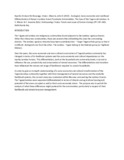Ecological, Socio-economic and Livelihood Differentiation of Kenya's Lembus Forest Proximate Communities: The Case of the Tugen and Lembus
Abstract
The Tugen and Lembus are indigenous communities found adjacent to the Lembus igenous forests. Other than these two communities, there are several others inhabiting this area the surrounding districts. The Lembus igenous minority have been assimilated into ~ larger Tugen ethnic group so that it is difficult distinguish one from the other. The Lembus - Tugen belong to the Kalenjin group (or highland Nilotes).
Over the years, the socio-economic and even cultural construction of Tugeni/Lembus community has changed in terms of its livelihood systems and the socio-economic and cultural dependence on the nearby Lembus Forests. This differentiation, both at the household and community levels, is bound to influence the use, productivity and conservation of natural resources. The differentiation and transition have influenced the nature and range of livelihoods required to sustain households.
In order to gain an in-depth understanding of e socio-economic and cultural transformation of the Tugen/Lembus community together with their management of natural resources and the available livelihood systems, the current study was conducted within the area surrounding the Lembus Forests. The Tugen/Lembus were separated (differentiated) in terms of climatic and agricultural (ecological) potential of the areas occupied as well as their socio-economic status. The purpose was to permit the analysis of what these differences might portend for the communities, particularly in respect of their livelihoods and natural resource management.

